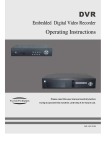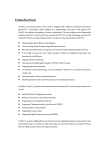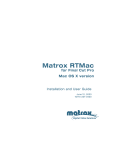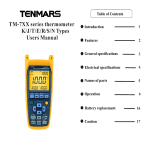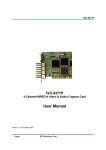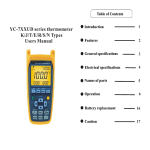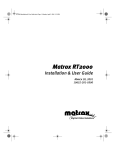Download 2.3 Connection
Transcript
>>Stand-alone DVR User Manual INDEX Chapter1:Parameter and connector definition ························································· 2 1.1 Parameter································································································· 2 1.2 DVR appearance ························································································ 3 1.3 Connector definition ···················································································· 3 1.3.1 Front panel button definition: ································································· 3 1.3.2 Front panel pilot lamp definition: ···························································· 4 1.3.3 Rear panel························································································ 4 1.4 Remote Controller instruction········································································· 5 Chapter2 System Installation and Notes········································································ 6 2.1 Notes ······································································································ 6 2.2 Package checking ······················································································· 7 2.3 Connection ······························································································· 7 2.3.1 Video connection ··············································································· 7 2.3.2 RS-485/RS232 connection ···································································· 8 2.4 HDD installation ························································································ 8 2.5 GND connection ························································································ 8 Chapter3 Operation································································································ 8 3.1 System operation illustration and glossary ·························································· 8 3.2 Start-up ··································································································· 9 3.3 Shutdown································································································· 9 3.4 Status bar operation ····················································································· 9 3.5 Other operations························································································11 3.6 Main menu ······························································································12 3.6.2 Video Setting ···················································································14 3.6.3 Record Setting··················································································16 3.6.4 Alarm setting ···················································································18 3.6.5 Network Setting················································································20 3.6.6 User Management ·············································································23 3.6.7 File Management ··············································································25 3.6.8 Storage Management ··········································································26 3.6.9 System Info···················································································27 Chapter4 WAN connection ······················································································28 4.1 PPPOE ···································································································28 4.2 Router forwarding······················································································29 1 >>Stand-alone DVR User Manual Chapter1:Parameter and connector definition 1.1 Parameter Model parameter 4CH D1 DVR Compression Video source Video Audio Storage and backup Network I/O 16 CH D1 DVR H.264 PAL:100 frame PAL:200 frame PAL: 400 frame NTSC:120 frame NTSC:240 frame NTSC: 480 frame Live resolution D1(704×576) Recording resolution D1(704×576) Input Rec. 8CH D1 DVR 4 CH BNC 8 CH BNC 16 CH BNC Output 1 CH BNC,1 CH VGA(resolution 1280×1024,60Hz) Video standard PAL、NTSC adjustable Audio input 4 CH 8 CH 16CH Audio output 1 CH 1 CH 1CH Compression G.723 Recording mode Manual,Schedule,Motion detect,alarm recording Playback 4CH 8CH 16CH HDD 8 SATA HDD HDD volume 2T Backup USB device backup,network backup,Local HDD backup Net port Ethernet10/100Base-T,RJ45 protocol UDP/IP,TCP/IP,IGMP(multicast),DNS&DHCP client, PPPOE,DDNS, SMTP, UPNP Net browsing method Client software,IE browsing CMS Preview 36CH video in client software,manage 255 pcs DVR Alarm input 16 CH 16 CH Control way Alarm output 4CH RS485 1x RS485,support PTZ control RS232 1 个 RS232 USB 2 Remote control Support Mouse USB mouse Panel Support(optional) Network control Support Volume 430mm*375mm*90mm 2 16 CH >>Stand-alone DVR User Manual 1.2 DVR appearance 1.3 Connector definition 1.3.1 Front panel button definition: Power: Turn ON/OFF system. If system takes the soft shutdown , you should press this button to reboot the system. Menu: Enter system menu and return. Record: Enter recording setting menu. Files: Enter video file management menu. Mode: Split the screen PTZ: Enter PTZ control interface Page Up: Turn up. Page Down: Turn down. Info: Enter into system info menu Back Space 3 >>Stand-alone DVR User Manual Up: Move up cursor. Down: Move down cursor Right: Move right cursor Left: Move left cursor Enter Shuttle outside: the function is the same with the Right and Left Key Shuttle inside: frame forward function during playback, 1.3.2 Front panel pilot lamp definition: PWR:Power indicator light,It is green color when stand-by and red when work. HDD:HDD work indicator light. REC:Recording indicator light, it is on when DVR is recording. IR: IR receiver and front panel key indicator light 1.3.3 Rear panel A B C D E F G H I J K . A、Video Input B、Audio Input D、Audio output E、 SPOT Output:Vout1 F、SPOT Output:Vout2 G、VGA Port H、USB Port I、 RJ45 Port J、Alarm Input K、Alarm Output 4 C、line in >>Stand-alone DVR User Manual 1.4 Remote Controller instruction Pic.7 Remote Controller (1) Remote Controller key definition 1. Figure key(0~9):Input figure and letter. In preview model, figures 1~8 are used to switch 1-8chennel. 2. Power:ON/OFF system power 3. PTZ:Enter PTZ control interface 4. Device Number:Enter device No. input dialog box 5. Back Space:Delete the current input 6. Page Up:Turn up, reduce the number 7. Page Down:Turn down、add the number 8. Menu:Enter main menu / return 9. ESC:Return, exit the operation 10. Mode:Switch quad ,single picture and PIP display mode;Long time press as the switching key of other mode; please refer to “Remote controller combination key definition”. 11. Shift:Switch channel display position. 12. Files:Enter video file management dialog box 5 >>Stand-alone DVR User Manual 13. Information:Check system info 14. Mute:ON/OFF system audio output 15. Alarm clear:Clean system alarm prompting information 16. Record:Enter recording setting dialog box 17. Play/Pause 18. Frame Forward:Single frame play 19. Speed back:Speed back play key,there are 4 levels:1X、2X、3X、 4X 20. Speed Forward:Speed forward play key,there are 4 levels:1X,2X、3X、 4X 21. Up:Cursor move up 22. Down:Cursor move down 23. Left:Cursor move left 24. Right:Cursor move right 25. Enter (2) Remote controller combination key definition 1、 (Mode) + (mute) : Long time press “Mode” button till you heard “DiDi” sound and then press “Mute” button to ON or OFF key voice. Chapter2 System Installation and Notes 2.1 Notes ◆ Safety ※ As indoor equipment, this machine shouldn’t be put it in moist or dusty place In order to prevent from 6 >>Stand-alone DVR User Manual danger of short circuit and electric shock. ※ Once any solid or liquid come into the machine, please cut off power immediately, And then ask the technician to inspect it before you use it again. ※ If there is any malfunction with the machine, you should ask the technician to examine and repair or contact with the dealer, please don’t ever mend it by your self. ◆ Installation place ※ You should select the right place where the air can circulate over the machine, thus can prevent the machine from overheating. ※ This machine shouldn’t be installed in hot places near radiator or vent-pipe, or some other places where is insolated or dusty and moist, as well as those places with strong magnetic field or with mechanical shake and strike. ◆ Copyright protection ※ Please don’t infringe the related right of the third party when you make image recording program. ※ Any change or modification on this machine without our permission might destroy the machine and cause many inconvenience to the user. 2.2 Package checking After open the carton, please check whether the host and spare parts are in good condition, if anything wrong, please stop using and contact your supplier immediately. Also please check whether the following items are complete: ◆ User manual X 1pcs ◆ IR remoter X 1pcs ◆ Remoter batteries X 2pcs ◆ QC Certificate X 1pcs HDD cable: SATA HDD cable X several ◆ Power cable X1pcs ◆ HDD bracket and screws X 1set ◆ ◆ ◆ Client manager software CD X 1pcs USB mouse x1pcs 2.3 Connection 2.3.1 Video connection A、Video input connection: System support 4/8/16CH CVBS input, input resistance is75Ω,BNC connector。 B、Video output connection: a) System support 1CH CVBS output,output resistance is75Ω,BNC connector。 b) System support 1CH VGA output,resolution 1280x1024 60Hz / 1024x768 60Hz/ 800x600 60Hz optional。 7 >>Stand-alone DVR User Manual 2.3.2 RS-485/RS232 connection Host have one standard RS-485/232 port,. RS485 is used to control PTZ decoder and camera, RS232 is used to debugging software and other communications expanding. Host builds in many PTZ/camera protocols, it can connect 4 /8/16PTZ decoders/cameras at the same time, and each channel corresponds to one. Default PTZ decoder/camera decoder is same as its channel number. 2.4 HDD installation System supports 8pcs SATA HDD,and set the jumper on SATA I(Limit to 1.5Gb/s Operation )mode. After that, use bracket to fix the HDD in the DVR, connect the power cable and date cable. 2.5 GND connection After connect the signal cable, please connect the screw with the grand to protect the host. Chapter3 Operation 3.1 System operation illustration and glossary 1) Selection box: Used to point the checked operation, yellow frame, and press direction key to move it. 2) Checked:The position of selection box is the current operation position. Move the box to every target means check this item. 3) Click:After checked the items, press “OK” button to click this object. 4) Soft keyboard:Checked edition box, press “OK” button to pop-up soft keyboard. You can do input work via this keyboard. 5) Icon:Such as ENTER、 6) Edit box:used to input figure、letter etc, it include text input box and figure input box. etc .“clink” this button to realize “Confirm”、“Cancel” and “enter next page” function. Text input box:Select the text input box, such as the "host name" amendment etc. Input the text in Software or the figure on IR remoter. Figure input box: Such as time set, host No. set etc. Input the text in Software or the figure on IR remoter. Also support page up “ descending. 8 ”、page down“ ”key to increasing or >>Stand-alone DVR User Manual 7) Drop-down box 8) List Box:Used to list the file and other items. Support pitch on single line and page up, page down. 9) Progress Bar 10) Check box :Only support page up “ ”and page down“ ”key to rolling option. :Press left and right key to increase and reduce the value. :choose and press “OK” to confirm it. 11) Radio button :Make a mutually exclusive choice in same list or group. 12) Soft keyboard:press “OK” button in edit box to pop-op soft keyboard. 3.2 Start-up 1) Start system:Insert 12V adapter output connector into DVR power port, set the power switch(on back panel) on “ON” position, now the PWR indicator on front panel is light, when its color is green, system is stand-by (default working status).Press the power key “ ” on front panel or the power key “ ” on IR remoter, the power indicator will change into red, system will turn into working status; When indicator is red, system will turn into working status after power it. 2) Host NO. isn’t 0:If the host No. isn’t 0 and when you want to start the system in IR remoter, please follow below way: 3) Press power key “ ” on the IR remoter till you heard “DIDI” two prompt sound,input the host No. And then press “OK”. If the host No. is match, the system will start. 3.3 Shutdown 1) Normal shutdown:When system is in working status, press the power key “ ” on front panel or ” on the IR remoter to pop-up system close dialog box, press “OK” button, the the power key “ system will turn into stand-by status. 2) Forced shutdown:Long time press the power key “ ” on front panel or the power key “ ” on the IR remoter, system will be forced shutdown. 3.4 Status bar operation When system running, exit the operation interface and main interface, the status bar will display in the bottom left corner. It will show the system mute audio monitor and login status, also include system info query/ alarm/backup and system clock, as below Pic.11 Status Bar 9 >>Stand-alone DVR User Manual :Start menu button, press it to bob up start menu. / :Mute ON/OFF button :Video/Audio monitoring status and display mode option / :Login/Lock button : Alarm query :Time and date setting button 1) Display/Hide In preview status, press any key to display status bar. Press return “ ” to hide it. 2) Mute Pitch on “Mute” icon, press “OK”, system will mute “ ”or open the voice“ ”. 3) Video/Audio monitoring status and display mode option Pitch on monitoring select box, directly input the channel No. to switch to this channel and display in single picture; press pageup“PGUP/-”or pagedown“PGUP/+”to switch picture position; press “ ”button to switch display mode: 16CH->8CH->Quad->PIP-> Single-> cycle 4) Login/Lock After start system, system is in lock status, and the user can only switch the channel and display mode in panel and IR remoter. If you want to do other operation, you should login system and after that, you can do relevant operation in authorities. a) System Login On status bar, move the cursor to LOGIN/LOCK icon ,press “OK” to pop-up login dialog box, as below. Input the user name and password and press “OK” to enter login status, the LOGIN/LOCK icon will change into login status icon . When system is locked, any operation that needs to be authorized will trigger pop-up login dialog box. Now the user should login system and then continue his operation.(Note:no password in new DVR) 10 >>Stand-alone DVR User Manual Pic.12 User Login b) System Lock On status bar, move the cursor to LOGIN/LOCK icon“ status “ ”,press “OK” to turn into lock ”.In login status, if user do not do any operation in 2 minutes, the system will turn into lock status automatically. 5) SYSTEM INFO When alarm occurred, the system info icon will change into alarm prompt button icon “ ”, press this button to pop-up alarm information query dialog box. (Refer to “System info”/“alarm query” chapter). 6) Time and date setting Move the cursor to time setting button“ ”to pop-up system time setting dialog box. (Refer to “System info”/“time setting” chapter) 3.5 Other operations 1) Host number operation: a) Start up:If the system had been set the host No., that‘s to say the host No. is not 0, when you want to start system, the host No. should match. Detailed start method please refer to “Start system”/“Start system when the host No. is not 0”. b) Match IR remoter:If the system have the host No., that‘s to say the host No. is not 0, when the IR remoter control this DVR after it operated other host (not 0 host number), you should do IR remoter match and then you can control this DVR by that remoter .The match purpose is to control several hosts in one IR remoter. Match method::Press host No., the system will pop-up host No. match dialog box after “DIDI” two sound, as follow: Input the host number in “Input host No.(0~99)”edit box and press “OK” to confirm. Please refer to the oval box in the picture. 11 >>Stand-alone DVR User Manual Pic.13 Host No 2) Storage device format Enter “Main menu”/“Storage management”,pitch on the device that need to be formatted, press button“ ” to format the chosen device. After the format, the file format is FAT32. 3.6 Main menu Press menu button to enter main menu interface, click on the relevant icon button and press “OK” to enter the corresponding menu item. Pic.14 Main Menu 3.61. System Set In “System Set” page, you can set the host name, host number and language. In its sub-menu, you can set system time, recover the factory settings and upgrade the system software. 12 >>Stand-alone DVR User Manual Pic.15 System Set 1) Name:input and amend host name 2) Number:Amend the local host number 3) Language:choose the system language 4) Time Zone:choose the system time zone 5) NTP:Check the NTP, synchronization the time with services 6) Time set:Presses “Time Set” button to pop-up the time setup dialog. As below: Pic.16 Time Set 7)FACT.SET: press “FACT. Set” button to pop-up the “recover factory set” dialog. As below: 13 >>Stand-alone DVR User Manual Pic.17 Recover Factory Set After recover factory set, the host number, video format, recording setting parameter etc. will not change. 8) Upgrade:Copy the system upgrade file to your Flash disk, and insert it into USB port of DVR, press “upgrade” button to pop-up “Search upgrade file” dialog as below: Choose the right upgrade file, press confirm button to pop-up “Upgrade Confirm” dialog. The process of upgrading will last about 1 minute and the system will automatically restart, after the completion of the upgrade system. NOTE:You can not cut off the power when upgrading, otherwise the DVR system will collapse. Pic.18 Search Upgrade File 3.6.2 Video Setting Set the system video properties, include the output channel, PTZ, video channel title, video color parameter etc. VIDEO SET menu as below: 14 >>Stand-alone DVR User Manual Pic.19 VIDEO SET Display setting: Video standard, VGA resolution, PIP, position cycle (Loop) 1) VGA resolution: 800x600、1024x768、1280x1024 optional 2)Video standard: You can choose PAL or NTSC as your system format. If you change the system standard, system will be restarted 3) PIP setting: Choosing the corresponding channel, when set the PIP, this channel will displayed on the top of the screen. 4) POS.CYCLE: Enable image cycle, choose cycle interval, the picture will automatically be cycle displayed in selected time. 5) Channel parameter: a) Channel number:To select the appropriate channel(1~16) b) Channel title:Amend channel title c) Color parameter:To adjust the appropriate channel color parameter(Brightness、contrast、 chroma 、saturation),press color parameter amendment button to enter color parameter amendment page, as below: 15 >>Stand-alone DVR User Manual Pic.20 Progress bar Press left or right button to adjust parameter values, press UP or DOWN button to switch parameter type, press PGUP or PGDW to switch channel d) PTZ setting:Enter PTZ setting interface Pic.21 PTZ SET PTZ SET:In this page, you can choose protocol of PTZ which associate with this channel, the baud rate and PTZ ID code. Default PTZ ID code is same as the number of channel that the PTZ associated with. PTZ CTRL:Press this button to enter PTZ control interface. You can control it via operation panel. In this interface, you can set and call the preset point, can control the PTZ UP/DOWN/LEFT/RIGHT run, can control the zoom, focus and aperture ,can control the PTZ cruising. e) Apply to all CH.:choose this item and press confirm, you can copy this channel setting to others channel. 3.6.3 Record Setting Set the recording bit stream、record mode etc 16 >>Stand-alone DVR User Manual Pic.22 Record Setting Recording mode choose:You can choose Manual recording, Timing recording and Alarm recording a) Manual recording: After choose the channel, this channel will start to recording under scheduled parameters (refer to recording parameter setting), and you should manual stop the recording if you need to, the method is to anti-election and confirm it. b) Schedule Recording First you should set the recording time period and then turn on this channel recording. When in scheduled time period, the system will start recording automatically till the time period over. Time period setting: press relevant channel time period setting button to enter setting page. Please be noted that the time period can not be in two days. c) Sensor recording:Refer to alarm setting 2) Bit stream parameter setting:setting interface as below。 Pic.23 Stream setting a) .Frame rate setting:you can set recording frame rate,PAL format from 1~25FPS optional, NTSC format from 1~30FPS optional. b) Image quality level:There are 6 level image quality.1 is best,6 is worst。The higher level of 17 >>Stand-alone DVR User Manual image quality, the greater the stream. The more clear image, the greater the share of network bandwidth and disk space. 3.6.4 Alarm setting Set the host alarm trigger channel and relevant trigger condition, setting interface as below: include “motion ” and “sensor” setup: Pic.24 Alarm set ● Video Detect: Set video lost alarm, motion detection alarm trigger condition and associated channel. Setting interface as below: 图 25 Video Detect a) Channel No.:Choose the channel that need to be set and the channel title will automatically display in the behind b) Trigger schedule:Set the trigger time periods. c) Alarming Duration:Set the alarm duration. After triggered alarm, system will output the alarm signal till you clean it by manual or the end of pre-setting alarm duration. d) Motion Detect: > Sensibility:Set the video motion detect sensibility,1~10levels optional,level 10 is highest , level 1is lowest。The higher-level set, the more sensitive when motion detected. > Prerecord:Set the prerecord time. After motion detect triggered alarm, > Recording duration:After motion detect triggered alarm, system will on-going record for the 18 >>Stand-alone DVR User Manual set duration time > Area setting:Set the motion detect area. Press setup button to enter the setup interface, as below:: Pic.26 Video detect area setting Area selection:press direction button to move the curser to the detected area starting point, and press “Enter” button to confirm it, refer to the “1” position on above picture. After the confirmation of starting point, press direction button to set the detecting area, refer to the “2” position on above picture. Press “Enter” button to finish the setting, the selected area will become to green color, refer to the “3” position on above picture. Use same method to set other detecting area. Area Edit:Moving the selection box to the appropriate location in the selected area, use above-mentioned area selection way to edit the detection area. Apply to all channels: Apply this video detection parameter setting to all channels ● Sensor: Set sensor trigger time、associate alarm and associate recording channel etc. Setting interface as below a) Sensor channel No.:select sensor input channel number(1~16) b) Trigger on:Unlock sensor trigger c) Trigger schedule:Set the trigger time periods d) Associate Channel:Set alarm trigger associate recording channel e) Record associate >Prerecord time:Set the prerecord time. After sensor triggered alarm, system will ahead of “prerecord time” to start the recording > Recording duration:After sensor triggered alarm, systems will on-going record for the set duration time. 19 >>Stand-alone DVR User Manual > Sound prompt:After triggered alarm, system will output “du…du …”warning tone. >Buzzer:After triggered alarm,the buzzer on the machine will output “Di ...Di... Di” warning tone. > Relay:After triggered alarm,system will close the switch of relay to connect the outer alarm system. >Alarming Duration:Set the alarm duration. After triggered alarm, system will output the alarm signal till you clean it by manual or the end of pre-setting alarm duration. ● Alarm output Set the alarm duration, set the associate for sensor trigger, video loss, motion detection a) set the alarm duration >> Sensor: sensor alarm is triggered, the alarm duration time >> Motion Detection: Motion detection triggered alarm duration >> Video loss: video loss triggered alarm duration b) Alarm associate equipment First choose the way to associate, such as the sensor trigger, video loss, motion detection, then select the associate function. >> Sound Prompt: the alarm is triggered, the system will output”du…..du….du” warning tone. >> Buzzer: alarm is triggered, the buzzer on the machine will output “Di…Di….” warning tone >> Relay: alarm is triggered, the system will close the relay switch, connected to an external alarm equipment. >> Send e-mail: alarm is triggered, send an e-mail, 3.6.5 Network Setting System support LAN、DDNS and PPPOE. Setting interface as below: 20 >>Stand-alone DVR User Manual Pic.33 1) Network Setting Protocol Type:Net transport protocol can be “UDP” or “TCP”. Usually choose “UDP” in LAN and choose “USE Multicast”; Choose “TCP” in WAN. NOTE: In WAN, please close “USE Multicast”! 2) HTTP port set:Set HTTP port, default is 80.If this port changed, when login the host via Web server (IE),The IP address input method is IP add “:”and new port number. For example:(192.168.1.121:88): 图 34 Web Server Login 3) 4) 5) 6) Media port: this port can be amended, the fault is 34443 Cell phone Surveillance: the fault port is 15961 Network streaming: support D1, CIF adjustable Local Connect setting:Local Connect setting also can set host IP, gateway and other clauses. You can choose “Obtain an IP automatically” or manual input IP. Setting interface as below: 21 >>Stand-alone DVR User Manual Pic.35 Local Setting a) Obtain an IP automatically: When connected network support DHCP IP(DHCP server open),when you choose “Obtain an IP automatically”,DHCP server will allocate an available IP. System default setting is “Obtain an IP automatically”. b) Manual input IP: System input manual input IP. When choose “Use the following IP address”,IP address filed will be editable, and you can input an IP address ,and then press “OK” to confirm it. DNS server can set in same way. 7) DDNS setting: System support DDNS setting. You need to apply an account from the DDNS server provider(Such as Peanut passport:include account number, password and domain name,known as web site,for example:videoweb.vicp.net),and then input the account information into “DDNS setting” column, press “OK”, the system will connect the DDNS server automatically to apply DNS. The server will analyze corresponding domain name to host actual IP address. When the user wants to login the DVR, he only need to input the domain name in IE. Setting interface as below: Pic.36 DDNS Setting 22 >>Stand-alone DVR User Manual 8) PPPOE setting:System support ADSL PPPOE dial connection directly. Connect the host with the ADSL model via RJ45 or LAN,it will dial automatically or by manual to connect the WAN .PPPOE setting interface as below: Pic.37 PPPOE Setting 9) EMAIL alarm Email alarm function occurs when the host alarm (motion detection, video loss, sensor alarm), the system automatically sends messages to the specified mailbox, users can receive messages about the host alarm information; a). SMTP port number: to send or relay email from this port, the DVR take the 25 international standards in the Post Mail server port as the default port; some other e-mail SMTP port may use the other port, the user can login the email box through IE view the SMTP port number; b). SMTP server: mail server name, server name usually is the suffix of SMTP E-mail, such as sina email, its SMTP server is “smtp.sina.com”.; some other e-mail SMTP sever may be different ones, the user can login the email box through IE view the SMTP sever; c). Sender address, the sender password: The E-mail address and password for IE login; d). Recipient Address: the email address of recipient 3.6.6 User Management Create the user account, modify the user’s access, change password etc. Setting interface as below: 23 >>Stand-alone DVR User Manual Pic.30 User management 1) Add/Delete user account: System can manage 8 local accounts. Admin is default administrator account which can not be deleted. Press “Add” button to pop-up user account create dialog box. As Below: Pic.31 Create a new account Input user name and password, press “ok” to finish the creation. NOTE:The maximum length of User name and password is 16 characters! 2) Change password: Press change password “ ” to popup the changing password dialog box, as below: 24 >>Stand-alone DVR User Manual Pic.32:Change password 3) Authority settings:Charge user’s privilege and press “MODIFY” to confirm it. 3.6.7 File Management Manage the recording files,can search, playback and backup the recording files based on the given search condition. Search conditions include channel No., Date type, Record type, Recording date and search periods. Interface as below: Left is date column, the blue background of the date on behalf of the day that has recording files. 1) Recording Search: Input Search channel No., Recording date and search time period. Press“ ”,It will show the time period which has the recording file in “Start time”、“End time” under the each chosen channels. 2) Playback:As above, input the search condition,press“ 3) Backup:As above, input the search condition,press“ ”to play the eligible video files. ”to copy the eligible video files to pointed device. Backup device selection interface as Pic.29: 25 >>Stand-alone DVR User Manual Pic.28 Recording Files Management In operation interface, you can choose “ ” or “ ” this file to pointed device. 3.6.8 Storage Management Manage the storage device, display the device working condition, format and file selection. Interface as below: Pic.38:Storage Management 1) 2) Device Info:Select and display the device information, as above: Device Format:Select the device, press “Delete” button to format this device in FAT32 division format. 3) File management:Press the device to enter “Stored File Info” list. In this list, you can choose the recording file to play or choose upgrade file to update the system. 26 >>Stand-alone DVR User Manual 3.6.9 System Info Enter system info dialog box to check the host “Serial Number”, “Software Version”, “IP Address” and “MAC Address” etc Pic.39:System Information 1) Host Information: Display the host serial No., software version, IP address and MAC address. 2) Link statistics: Press “Link Stat.” to check the customer login information, and you can you can disconnect this IP connection. As below: Pic.40:Link Statistic Above picture tell us the host is connected by two users. It also tells us the visitors IP, port No. and remote monitoring status. Channel status is displayed in 4 figures: “0” means close and “1” means open. The sequence is CH1-CH2-CH3-CH4.For example: 0101 means CH2 and CH4 are open and CH1 and CH3 are close. Select the connection IP and press “Disconnect” to cut off this connection。 3) Alarm information: Check the system alarm status which is displayed into matrix form chart; junction shows the incident triggered alarm types. Green color means no alarm and red color means alarm triggered. When alarm triggered, you can press the triggered incidents to clean the alarm. As below 27 >>Stand-alone DVR User Manual Pic.41:Alarm information 4) System log: Check the host operations recording. Input the date and press “SERACH” to list the operation recording. Pic.42:System Log Left is date column, the blue background of the date on behalf of the day that has operation recording Chapter4 WAN connection There are two methods to connect the DVR with WAN: one is PPPoE and the other is router forwarding. 4.1 PPPOE Please check relevant chapter. 28 >>Stand-alone DVR User Manual 4.2 Router forwarding 1) Set the host IP Set the host IP in“Local setting”,please refer to the chapter “Net set”. Note:Set the “protocol” in “TCP” when connecting the DVR with WAN. 2) Port forwarding Login the router and mapping following port. For example the Host IP Address is 192.168.1.63, The model of the router is CISCO WRT54G2V1.The router default IP is 192.168.1.1,Input then router IP in IE browser, will pop up a window .Then input the user name and password of the router(the user name and password of the router refer to the manual)login the router interface。Click “Applications& Gaming” then take the port forwarding: 80: WEB-port 34443: command port 34444: Real-time port 34445: on-demand port 34446: intercom ports 34447: Backup port 34448: Upgrade port 15961: Mobile phone Port 3) DDNS (Oray.net) Take dyndns for example: first login the website www.dyndns.com to apply user account and domain name. There are tow method to login DVR via dyndns domain name: One is setting the DDNS in host(refer to related chapter),the other is setting the DDNS in router. the second method setting as the following interface: 29 >>Stand-alone DVR User Manual 4)Remote login Input the Domain name in IE browser, for example: http://dns1986.dyndns.org:80 to open the surveillance window. You also can input the domain name in software to remote login the host. 5)IE trusted site and security level setting a) Open Internet Explorer and press“tool”->“Internet options”to bob up the following dialog box: 30 >>Stand-alone DVR User Manual b) Press“Trusted sites”and “sites” in red box as follow to bob up the “trusted sites” dialog box: c) Input the DVR IP, press“add” and “OK” to quit this dialog box. 31 >>Stand-alone DVR User Manual d) After above setting, press“default level” to set the “security level” into “Apply”. 32 “low” and then press >>Stand-alone DVR User Manual e) Or you can set the custom level: press “custom level”and enable all clauses under the “ActiveX controls and plug-in” options. f) In IE “Privacy” label, please cancel the “√” before the “Pop-up block”and then press“Apply”。 33 >>Stand-alone DVR User Manual 34



































